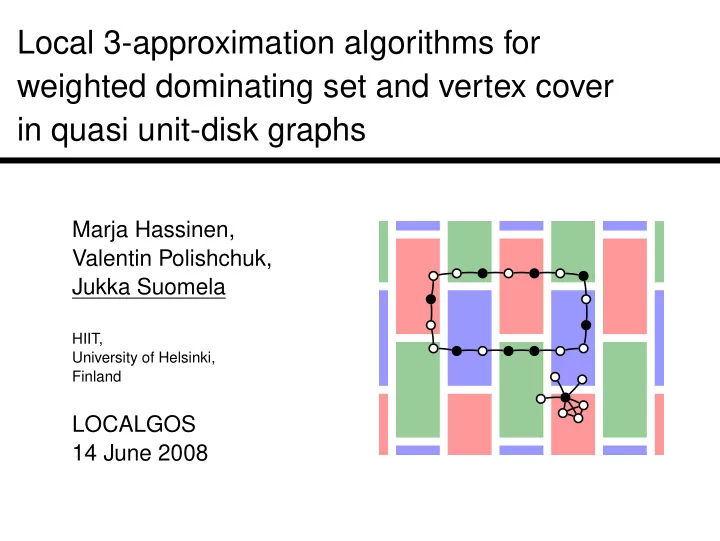

Local 3-approximation algorithms for weighted dominating set and vertex cover in quasi unit-disk graphs Marja Hassinen, Valentin Polishchuk, Jukka Suomela HIIT, University of Helsinki, Finland LOCALGOS 14 June 2008
Introduction Local algorithms: output at each node depends only on the constant-radius neighbourhood of the node (Linial 1992, Naor and Stockmeyer 1995) Assumptions: ◮ Unit-disk graphs ◮ Each node knows its coordinates Problems: ◮ Dominating set ◮ Vertex cover 2 / 37
Prior work Dominating set: ◮ 15-approximation (Urrutia 2007) ◮ 5-approximation (Czyzowicz et al. 2008) ◮ ( 1 + ǫ ) -approximation (Wiese and Kranakis 2007) Vertex cover: ◮ 12-approximation trivial ◮ ( 1 + ǫ ) -approximation (Wiese and Kranakis 2008) 3 / 37
Our contributions Simple local algorithm 3-approximation Small local horizon (locality distance): ◮ Present algorithm: r = 83 ◮ Wiese and Kranakis (2007): r = 46814 for 3-approximation Quasi unit-disk graphs Weighted versions 4 / 37
Dominating set Input — assumed to be a unit disk graph 5 / 37
Dominating set An optimal solution 6 / 37
Dominating set: local algorithm 7 / 37
Dominating set: local algorithm Divide the plane into 2 × 4 rectangles 8 / 37
Dominating set: local algorithm 3-colour the rectangles 9 / 37
Dominating set: local algorithm For each rectangle. . . 10 / 37
Dominating set: local algorithm For each rectangle construct an extended rectangle 11 / 37
Dominating set: local algorithm Extended rectangles are non-intersecting for each colour 12 / 37
Dominating set: local algorithm Extended rectangles are non-intersecting for each colour 13 / 37
Dominating set: local algorithm Extended rectangles are non-intersecting for each colour 14 / 37
Dominating set: local algorithm For each extended rectangle. . . 15 / 37
Dominating set: local algorithm For each extended rectangle, form a subproblem. . . 16 / 37
Dominating set: local algorithm . . . and solve the subproblem optimally 17 / 37
Dominating set: local algorithm Only inside needs to be dominated 18 / 37
Dominating set: local algorithm Repeat for each rectangle 19 / 37
Dominating set: local algorithm Repeat for each rectangle 20 / 37
Dominating set: local algorithm Repeat for each rectangle 21 / 37
22 / 37
Dominating set: local algorithm Union of local solutions 23 / 37
Dominating set: feasibility Each node is dominated in at least one subproblem 24 / 37
Dominating set: approximation ratio OPT is a feasible solution to each subproblem 25 / 37
Dominating set: approximation ratio OPT is a feasible solution to each subproblem 26 / 37
Dominating set: approximation ratio OPT is a feasible solution to each subproblem 27 / 37
Dominating set: approximation ratio OPT is a feasible solution to each subproblem 28 / 37
Dominating set: approximation ratio Factor 3 approximation from 3-colouring 29 / 37
Vertex cover The same basic approach applies here as well 30 / 37
Local horizon: worst case Consider a shortest path within an extended rectangle 31 / 37
Local horizon: worst case Pick even nodes — distance between any pair > 1 32 / 37
Local horizon: worst case Place disks of radius 1 / 2 on even nodes — non-intersecting 33 / 37
Local horizon: worst case Area bound: at most 42 such disks = ⇒ at most 83 nodes 34 / 37
Local horizon: average case 20 15 diameter 10 5 0 0 50 100 150 200 nodes 35 / 37
Local horizon: average case 1.0 fraction of connected graphs 20 0.8 15 diameter 0.6 10 0.4 5 0.2 0 0.0 0 50 100 150 200 nodes 36 / 37
Conclusions Local 3-approximation algorithm for dominating set and vertex cover Assumptions: (quasi) unit-disk graphs, coordinates known Unweighted case: local and poly-time Weighted case: local — but not necessarily poly-time! ◮ Other complexity measures for local algorithms besides the local horizon? Challenge: apply the same idea to other problems! http://www.hiit.fi/ada/geru — jukka.suomela@cs.helsinki.fi 37 / 37
References (1) J. Czyzowicz, S. Dobrev, T. Fevens, H. González-Aguilar, E. Kranakis, J. Opatrny, and J. Urrutia. Local algorithms for dominating and connected dominating sets of unit disk graphs with location aware nodes. In Proc. 8th Latin American Theoretical Informatics Symposium (LATIN, Búzios, Brazil, April 2008) , volume 4957 of Lecture Notes in Computer Science , pages 158–169, Berlin, Germany, 2008. Springer-Verlag. [DOI] M. Hassinen, V. Polishchuk, and J. Suomela. Local 3-approximation algorithms for weighted dominating set and vertex cover in quasi unit-disk graphs. In Proc. 2nd International Workshop on Localized Algorithms and Protocols for Wireless Sensor Networks (LOCALGOS, Santorini Island, Greece, June 2008) , 2008. To appear. N. Linial. Locality in distributed graph algorithms. SIAM Journal on Computing , 21(1):193–201, 1992. [DOI]
References (2) M. Naor and L. Stockmeyer. What can be computed locally? SIAM Journal on Computing , 24(6):1259–1277, 1995. [DOI] J. Urrutia. Local solutions for global problems in wireless networks. Journal of Discrete Algorithms , 5(3):395–407, 2007. [DOI] A. Wiese and E. Kranakis. Local PTAS for dominating and connected dominating set in location aware unit disk graph. Technical Report TR-07-17, Carleton University, School of Computer Science, Ottawa, Canada, Oct. 2007. A. Wiese and E. Kranakis. Local PTAS for independent set and vertex cover in location aware unit disk graphs. In Proc. 4th IEEE/ACM International Conference on Distributed Computing in Sensor Systems (DCOSS, Santorini Island, Greece, June 2008) , Berlin, Germany, 2008. Springer-Verlag. To appear.
Recommend
More recommend